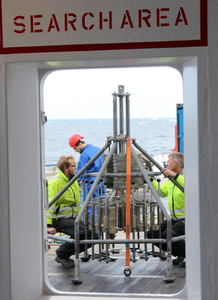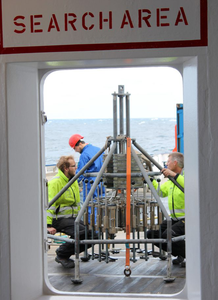Four weeks at sea for climate research
Expedition with R/V Maria S. Merian from Iceland to the Azores – researchers from Kiel and Mainz get to the bottom of climate history
JOINT PRESS RELEASE OF THE KIEL MARINE SCIENCE (KMS) AT THE CHRISTIAN-ALBRECHT UNIVERSITY AND THE MAX PLANCK INSTITUTE FOR CHEMSITRY
A complex system of surface and deep water currents circulates in the North Atlantic, between Iceland and the Azores, called the Atlantic Meridional Overturning Circulation (AMOC). The Gulf Stream, which transports heat to the North Atlantic, is part of the system and causes mild climates in western Europe. The ocean circulation is subject to tremendous changes, which have resulted in warm or cold climate periods in the past. For four weeks, the scientists from the Christian-Albrecht University in Kiel (CAU) and the Max Planck Institute for Chemistry in Mainz examined the climate history of the North Atlantic on the German research vessel R/V Maria S. Merian. They focused on the complex interactions between melt water input from the north, heat storage in the subtropics, and changes in deep water circulation, nutrient cycles, and the production of climate-relevant gases such as CO2. The researchers hope to gain new information on the functioning of the subtropical to subpolar North Atlantic for the natural fluctuations of the climate system. Their aim is to improve forecasts on human-influenced climate change. The expedition started on September 10 in Reykjavik in Iceland and ended on October 7 in Ponta Delgada in the Azores.

The ocean between Iceland and the Azores plays a special role not only for Europe’s modern climate, but also for the climates of the past. About one third of the Gulf Stream waters that heated up in the tropics is pumped towards Africa. The other two-thirds of the warm and salty Gulf Stream waters are transported with the North Atlantic current to the subpolar North Atlantic. Here, it gives off its heat into the atmosphere, and significantly affects the temperatures in our latitudes. In the past, fluctuations in the circulation triggered climate fluctuations like the Medieval Warm Period from the 10th to the 13th century, and the Little Ice Age from the 15th to the 18th century. An exact mechanistic understanding between the increase and decrease of the overturning currents (AMOC) and the associated climate effects is not yet fully achieved. As a result, forecasts produced with the existing climate models still have great uncertainties.
“The aim of our expedition is, above all, to gain new samples from the water column and the ocean floor sediments in order to better understand the previous changes in ocean circulation, especially from the North Atlantic west the Azores,” says Dr. Janne Repschläger from the Max Planck Institute for Chemistry in Mainz, who is in charge of the expedition. The expedition was planned within the framework of the Institute for Geosciences at the University of Kiel, and the marine scientific focus Kiel Marine Science (KMS). “With the analysis of the newly extracted sediment cores we can expand our knowledge of natural climate fluctuations in the follow-up to our sampling campaign, and provide new data for climate simulations,” Repschläger continues.
The researchers were able to extract a total of 206 meters of drill cores from ocean floor sediments at 30 sampling stations along the Mid-Atlantic Ridge. First on-board examinations revealed that the cores contain a total of up to three glacial cycles, including the Holocene and the deglaciation phase after the last ice age 20,000 years ago. (Friederike Balzereit)
